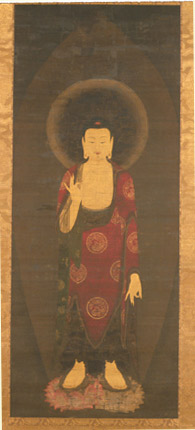
Fig. 4 This painted image of Amida (Sanskrit: Amitabha), the Buddha of the Western Paradise, performs the gesture of teaching (vitarka mudra) with both hands. In East Asia, the making of this gesture with one raised and one lowered hand signifies Amida's welcoming descent from heaven (raigo) to greet the soul of a faithful devotee at death. Painted and sculpted versions of this theme became popular in Japan during the 12th century and were placed near the deathbed of a devotee so that he or she could see it. It was thought that saying Amida's name at the moment of death ensured rebirth in his paradise, a goal of many believers. Sometimes, threads were attached from the hands of the dying individual to the hands of Amida, thus providing a direct contact with the salvific power of the Buddha, and consequently, a straight line to his paradise.
Descent of Buddha Amitabha (Amida Raigo). Japan. Kamakura period, late 13th century: hanging scroll, ink, color, and gold on silk, 38 3/4 x 16 1/2" (98.4 x 41.9 cm), 1979.191
